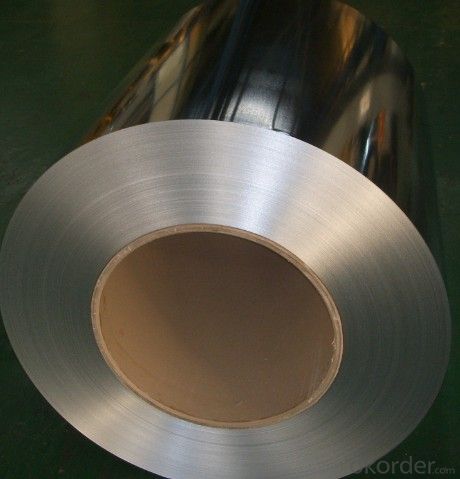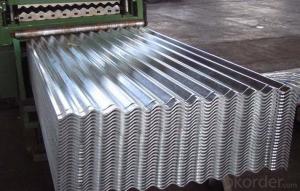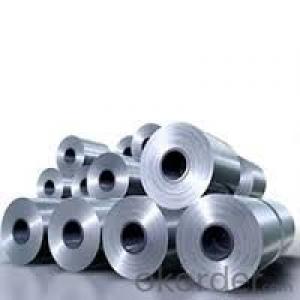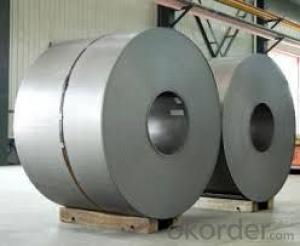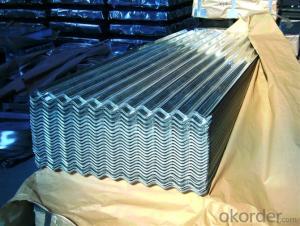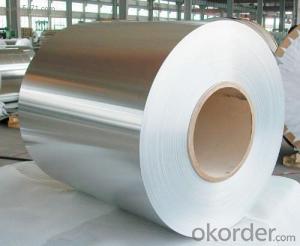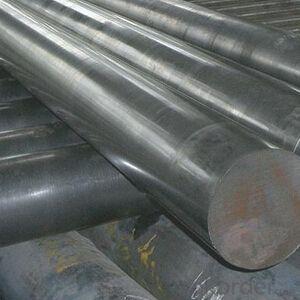Hot-dip Zinc Coating Steel Building Roof Sheets in Coil Prime Quality
- Loading Port:
- Tianjin
- Payment Terms:
- TT OR LC
- Min Order Qty:
- 50 m.t.
- Supply Capability:
- 10000 m.t./month
OKorder Service Pledge
OKorder Financial Service
You Might Also Like
1.Structure of Hot-Dip Galvanized Steel Sheet Description:
Hot-dip galvanized steel coils are available with a pure zinc coating through the hot-dip galvanizing process. It offers the economy, strength and formability of steel combined with the corrosion resistance of zinc. The hot-dip process is the process by which steel gets coated in layers of zinc to protect against rust. It is especially useful for countless outdoor and industrial applications. Production of cold formed corrugated sheets and profiles for roofing, cladding, decking, tiles, sandwich walls, rainwater protective systems, air conditioning duct as well as electrical appliances and engineering.
2.Main Features of the Hot-Dip Galvanized Steel Sheet:
• Excellent process capability
• Smooth and flat surface
• Workability, durability
• Excellent anticorrosive property
• High strength
• Good formability
• Good visual effect
3.Hot-Dip Galvanized Steel Sheet Images

4.Hot-Dip Galvanized Steel Sheet Specification
Standard: ASTM, JIS,EN
Grade: CS, DX51D+Z,SGCC, SS 230~550,S220GD+Z~S550GD+Z, SGC340~SGC570
Thickness: 0.1mm~5mm
Width: max 2000mm
Coil weight:3-12 MT
Coil ID:508/610mm
Surface structure: zero spangle, regular spangle or minimum spangle
Surface treatment: Chromate treatment, Oiled/dry, skinpassed/non-skinpassed
Packing: Standard seaworthy export package
Technology test results:
Processability | Yield strength | Tensile strength | Elongation % | 180°cold-bending |
Common PV | - | 270-500 | - | d=0,intact,no zinc removal |
Mechanical interlocking JY | - | 270-500 | - | d=0,intact,no zinc removal |
Structure JG | >=240 | >=370 | >=18 | d=0,intact,no zinc removal |
Deep drawn SC | - | 270-380 | >=30 | d=0,intact,no zinc removal |
EDDQ SC | - | 270-380 | >=30 | d=0,intact,no zinc removal |
5.FAQ of Hot-Dip Galvanized Steel Sheet
We have organized several common questions for our clients,may help you sincerely:
1.How about your company?
A world class manufacturer & supplier of castings forging in carbon steel and alloy steel,is one of the large-scale professional investment casting production bases in China,consisting of both casting foundry forging and machining factory. Annually more than 8000 tons Precision casting and forging parts are exported to markets in Europe,America and Japan. OEM casting and forging service available according to customer’s requirements.
2.How to guarantee the quality of the products?
We have established the international advanced quality management system,every link from raw material to final product we have strict quality test;We resolutely put an end to unqualified products flowing into the market. At the same time, we will provide necessary follow-up service assurance.
3. How long can we receive the product after purchase?
Usually within thirty working days after receiving buyer’s advance payment or LC. We will arrange the factory manufacturing as soon as possible. The cargo readiness usually takes 15-30 days, but the shipment will depend on the vessel situation.
- Q: What is the average price per square meter of steel sheets?
- The average price per square meter of steel sheets can vary depending on various factors such as the type, thickness, quantity, and current market conditions. It is recommended to consult with suppliers or conduct market research to get the most accurate and up-to-date pricing information.
- Q: Can the steel sheets be used for magnetic shielding?
- Steel sheets have the ability to be utilized for magnetic shielding. Due to its ferromagnetic nature, steel can effectively redirect and absorb magnetic fields. By utilizing steel sheets for shielding against magnetic fields, a barrier is created which aids in preventing the intrusion of magnetic flux into a specific area. This characteristic makes steel sheets a superb option for applications where magnetic shielding is necessary, such as in electronics, medical devices, and sensitive laboratory equipment. However, the effectiveness of steel sheets for magnetic shielding may be influenced by various factors, including the thickness and composition of the steel, as well as the strength and frequency of the magnetic field being shielded. Thus, it is crucial to consider these factors and seek guidance from experts to ensure the appropriate steel sheets are chosen for optimal magnetic shielding.
- Q: Can steel sheets be used for insulation cladding?
- No, steel sheets are not typically used for insulation cladding. Insulation cladding is typically made of materials with better insulating properties, such as foam boards or reflective foil. Steel sheets are more commonly used for structural purposes or as a protective covering.
- Q: What are the different storage methods for steel sheets?
- There are several different storage methods for steel sheets, depending on the specific requirements and space availability. Here are some commonly used storage methods: 1. Flat storage: This is the most basic method where steel sheets are stored horizontally on a flat surface, such as the floor or metal racks. It is suitable for small quantities or when the sheets are not too heavy. 2. Vertical storage: Steel sheets can be stored vertically by placing them against a wall or by using specially designed vertical racks. This method saves floor space and allows for easy access and identification of different sheet sizes. 3. Cantilever racks: These racks have horizontal arms that extend outward from a vertical column, providing support for steel sheets placed on them. Cantilever racks are ideal for storing long and heavy steel sheets, as they allow for easy loading and unloading using forklifts or cranes. 4. Roll-out racks: These racks have rollers or ball bearings that allow steel sheets to be easily rolled in and out, similar to a drawer. Roll-out racks are useful when frequent access to different sheets is required, as they provide good visibility and easy retrieval. 5. A-frame racks: A-frame racks have angled arms that support steel sheets in a slanted position, resembling the letter "A." This method is suitable for storing large quantities of steel sheets and provides easy access while keeping them organized. 6. Automated storage and retrieval systems (AS/RS): These systems use computer-controlled mechanisms to automatically store and retrieve steel sheets. AS/RS can be designed as vertical lift modules or robotic systems, maximizing storage capacity and efficiency. It is important to consider factors such as sheet size, weight, accessibility, and safety when choosing the appropriate storage method for steel sheets. Adequate measures should also be taken to protect the sheets from moisture, dust, and other environmental factors that could potentially affect their quality.
- Q: Can steel sheets be used for food-grade applications?
- Yes, steel sheets can be used for food-grade applications. However, it is crucial to ensure that the steel sheets are made from food-grade stainless steel, such as Type 304 or Type 316, which comply with specific sanitary regulations and have excellent corrosion resistance properties. Additionally, proper cleaning and maintenance practices must be followed to ensure the safety and hygiene of the food contact surfaces.
- Q: Are steel sheets suitable for architectural mesh applications?
- Yes, steel sheets are suitable for architectural mesh applications. Steel sheets offer durability, strength, and versatility, making them an excellent choice for architectural mesh applications. They can be easily shaped, cut, and formed into various designs, allowing for the creation of intricate and aesthetically pleasing architectural mesh structures. Additionally, steel sheets can withstand harsh weather conditions and provide excellent security, making them a reliable option for architectural applications.
- Q: What factors affect the cost of steel sheets?
- Several factors affect the cost of steel sheets, including the current market demand and supply, raw material prices, manufacturing and processing costs, transportation and logistics expenses, as well as any applicable trade tariffs or taxes. Additionally, factors such as the type and quality of steel, size and thickness of the sheets, as well as any special finishes or coatings required, can also impact the overall cost.
- Q: Can steel sheets be recycled multiple times?
- Yes, steel sheets can be recycled multiple times without losing their properties or quality. Steel is a highly recyclable material that can be melted down and reused repeatedly, making it an environmentally sustainable choice.
- Q: Can the steel sheets be cut easily?
- Yes, steel sheets can be cut easily using various cutting methods such as shearing, plasma cutting, laser cutting, or mechanical sawing depending on the thickness and type of steel.
- Q: What are the environmental impacts of steel sheet production?
- The environmental impacts of steel sheet production include carbon emissions from the burning of fossil fuels during the manufacturing process, the consumption of large amounts of energy and water, and the generation of waste and pollutants such as particulate matter, sulfur dioxide, and nitrogen oxides. Additionally, the extraction of raw materials for steel production, such as iron ore and coal, can lead to deforestation, habitat destruction, and soil erosion.
Send your message to us
Hot-dip Zinc Coating Steel Building Roof Sheets in Coil Prime Quality
- Loading Port:
- Tianjin
- Payment Terms:
- TT OR LC
- Min Order Qty:
- 50 m.t.
- Supply Capability:
- 10000 m.t./month
OKorder Service Pledge
OKorder Financial Service
Similar products
Hot products
Hot Searches
Related keywords



